

Dredgers at Work
The great harbours and navigable rivers of the world would soon become silted up were it not for the incessant work of the dredger. Various types of dredgers, too, are used for the building of seaports and for the excavation of the world’s great canals
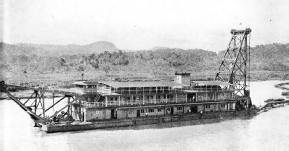
COMBINED PILEDRIVER AND DREDGER at work in the Panama Canal. Named Las Cruces, this vessel was built in 1929. The piledriving apparatus operates from the high tower at one end of the vessel and can be used for breaking up rocky obstructions.
ALMOST every navigable waterway and harbour in the world requires continual dredging. Bars of sand or mud are built up by tides and currents across the mouths of many rivers, and many a port would speedily cease to exist but for the steady work of the dredger.
All day and every day dredgers are at work in the River Thames between Tilbury (Essex) and the Nore. Without these ugly but useful craft the river would soon be unfit to carry the thousands of great ships and millions of tons of merchandise that make London the great seaport that she is.
Dredging work has deepened and made safe for the largest liners the harbour of New York. The Hell Gate Reef was once a peril to shipping using New York Harbour; so in 1875 three acres of the reef were tunnelled and the tunnels were filled with explosive. When this had been fired, huge columns of sea water rose 120 feet into the air and afterwards 45,300 cubic yards of broken rock were removed by grapple dredgers. The work took twelve and a half years. In 1885 a still larger area was blasted. This time no less than 294,000 cubic yards of broken rock had to be dredged out at a cost exceeding five million dollars, or £1,000,000.
At Calais Harbour, France, there were formerly only 3 feet of water over the bar at low tide. By dredging the depth has been increased to 15 feet. In the River Tyne dredging began in 1861 and in one year 5,250,000 tons of mud were removed. In the next quarter of a century 54,700,000 tons were dredged out and the depth over the bar was increased from 6 feet to 20 feet.
Preston (Lancashire) is a port on the Ribble, a small, winding and formerly unnavigable stream. Preston had ambitions to be a seaport and built a dock with a water surface of forty acres and machinery for dealing with a number of large cargoes at one time. At the same time she dredged out her sixteen-
Dredgers at Southampton have accomplished an amazing task. Not many years ago the wide bay to the west of Southampton was a lonely stretch of shallow water, much of it bare at low tide, where herons waded amid patches of sea grass, and across which passengers by train caught a glimpse of the New Forest on the far side of the Test Estuary. To-
This feat of engineering would have been impossible without the use of the dredgers by which 20,000,000 tons of mud were raised from the bottom of Southampton Water. All of it was raised into barges and 4,000,000 tons were carried away and dumped out into the sea as useless. The rest of the mud, however, was all used. The gravel washed out of it made a million tons of concrete. The rest of the spoil, mainly blue mud, was mixed with water and pumped into the bay behind the quay, to form 400 acres of new land. Exactly the same thing was done with the spoil from the Panama Canal. The spoil was used to make new land and a breakwater at Naos Island, at the south end of the canal where now is the harbour of Balboa.
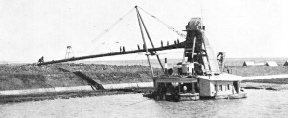 SAND DREDGING IN THE SUEZ CANAL. The original excavation was carried out by low-
SAND DREDGING IN THE SUEZ CANAL. The original excavation was carried out by low-
All the great canals of the world have been cut mainly by dredgers or by steam shovels. Those used in excavating the Suez Canal (opened 1869) were primitive and low-
The bulk of mud and sand moved yearly by the world’s dredgers is enormous. Most of it has to be dumped out in deep water. If it could all be used for making new land the nations would probably be the richer. It is said that the value of the soil washed down the Mississippi River in a year is not less than £3,000,000. At the mouth of the Mississippi the silting was so rapid that no amount of dredging could keep the channel clear; great converging jetties were therefore built. These narrowed the navigable channel from a width of two miles to 1,000 feet, so that the scour of the current is now sufficient to keep the channel deep enough for shipping.
The first dredgers were probably those built by the Dutch in the sixteenth century. A dredger was built in 1782 for clearing the mud out of Hull Docks. This was a bucket dredger worked by two horses. The buckets were 4 feet long, 13 in. deep, 12 in. wide at the mouth and only 6 in. wide at the bottom. With this primitive apparatus thirty tons of mud were drawn up daily at a cost of only 2½d. a ton. Such a dredger, however, would work only in soft mud, whereas the modern steam-
Climbing an Endless Chain
Up to 1877 the buckets used for raising spoil from the bottom never had a capacity of more than 9 cubic feet. To-
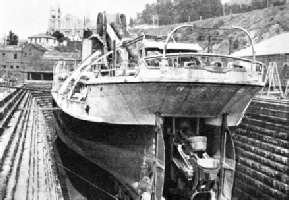
THE CHAIN OF BUCKETS in a bucket dredger is mounted on an inclined “ladder” whose lower end projects through an aperture in the vessel’s stern. The arrangement is clearly seen in this photograph of the bucket dredger Timaru at Port Chalmers, New Zealand. At the top of the ladder the buckets tip over a tumbler, emptying their contents over a chute either into the hold or into a barge alongside the dredger.
The earliest form of dredger was the bucket ladder dredger and this, vastly improved, is still much used. The ladder is a long, strongly built steel structure pivoted at the top end on a high steel frame which is placed amidships. Along the top side of the ladder are steel rollers, and the buckets climb the ladder along an endless chain. The buckets rising from the water tip, one after another, over the top tumbler, emptying their contents into the chutes below. The empty buckets return in a loosely hanging chain. Having reached the bottom, they are forced under the rigid end of the ladder so that each in turn is refilled. The ladder, with its buckets, passes down a well, which is a long narrow hole in the hull of the dredger.
The old type of bucket dredger discharges its dredged material into barges moored close alongside; these barges are generally made to carry from 300 to 500 tons. Formerly the dredgers were often engineless and were towed by tugs, but the modern practice is to put engines in the dredgers so that they are able to proceed under their own power. The bottom of the hold, or hopper of the barge is composed of steel trap-
When the appointed spot is reached for dumping the cargo the chains, which run in winches, are released, the doors fall open on their hinges and, as the great weight of mud falls out, the whole barge leaps upwards. Sea water runs in to take the place of the ballast, but as the ballast is heavier than the same bulk of water, the barge rides more lightly. This water is not pumped out of the barge.
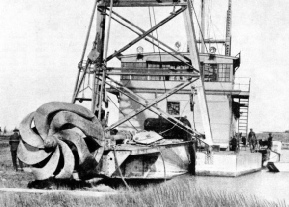
ELECTRIC HYDRAULIC DREDGE used for excavating a canal near Beauharnois, Quebec, between Lake Francis and Lake St. Louis on the St. Lawrence River. The revolving cutter has a diameter of 7 feet and cuts away the bank at a rate of 1,100 cubic yards an hour.
When the barge goes back to the dredger for a fresh load the mud gradually displaces the water until the water flows out through the scuppers. These barges are strongly built. They have to be strong, for rocks weighing a ton or more often come crashing down into their holds, with a force that would hole or sink any ordinary vessel.
Some dredgers carry their own hoppers, and so do not need attendant barges. A vessel of this type is provided with twin screws and two rudders. This variety of dredger is steadily becoming more popular.
Even when a dredger is needed for an enclosed harbour where only mooring winches are required to shift her, the designer generally recommends a self-
On a voyage the ladder is hoisted as high as possible out of the water and, when the dredger reaches her destination and gets to work, she has to be securely moored. Anchors are put out not only from bow and stern, but also from each quarter. As a rule the dredger is moored alongside the bank which is to be dredged , and is moved forward by mooring winches.
There may be as many as fifty buckets on the chain and in soft ground a modern dredger has excavated at a rate of no less than 700 yards an hour during the whole of a day’s work. But all sorts of ground are encountered, and when stones and rough material have to be lifted smaller buckets are fitted. Sometimes steel teeth are fitted to the lips of the buckets.
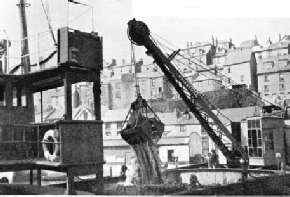
THE DIPPER DREDGE is a type of dredging vessel which strongly resembles a steam navvy used for land excavation. The Graball is equipped with a huge grab at the end of a long swinging boom. The grab is lowered to the floor of the harbour or river being dredged, the material is grasped in the huge metal jaws, and then the grab is raised and swung inboard so that the material can be dropped into the hold.
When solid rock has to be dredged it may be blasted, as with the reef in New York Harbour; but the modern practice is to use a rockbreaker, which is a sort of floating piledriver. A shaft runs down through the bottom of the rockbreaker and above this rises a strongly built steel tripod which may be as much as 40 feet above the water. The breaker or cutter is torpedo-
Dipper Dredge
When blasting is necessary a drill is used instead of a breaker. The drills are fixed in a frame and two or three may be used at once. They are mounted on sliding carriages. The drills are of any diameter required up to 6 in. and bore holes 5 or 6 feet deep. As each set of holes is bored the barge carrying the drills is moved a certain distance and the process is repeated. Divers are employed to fill the drilled holes with explosives.
Another type of dredger is the so-
A third type is the suction dredger, which works by means of a powerful centrifugal pump and sucks up from the bottom mud or sand, mixed with water. Water and sand together are discharged into the hopper. The sand settles to the bottom and the water finds its way out through the scuppers. The suction dredger is popular in low-
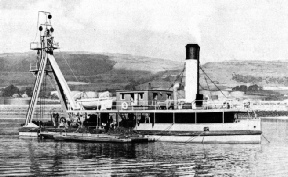
ROCKBREAKER IN THE RIVER CLYDE. During dredging operations carried out to deepen the river channel for the passage of the newly-
You can read more on
and
and
“World’s Largest Graving Dock”
on this website.
You can read more on
and
in Shipping Wonders of the World